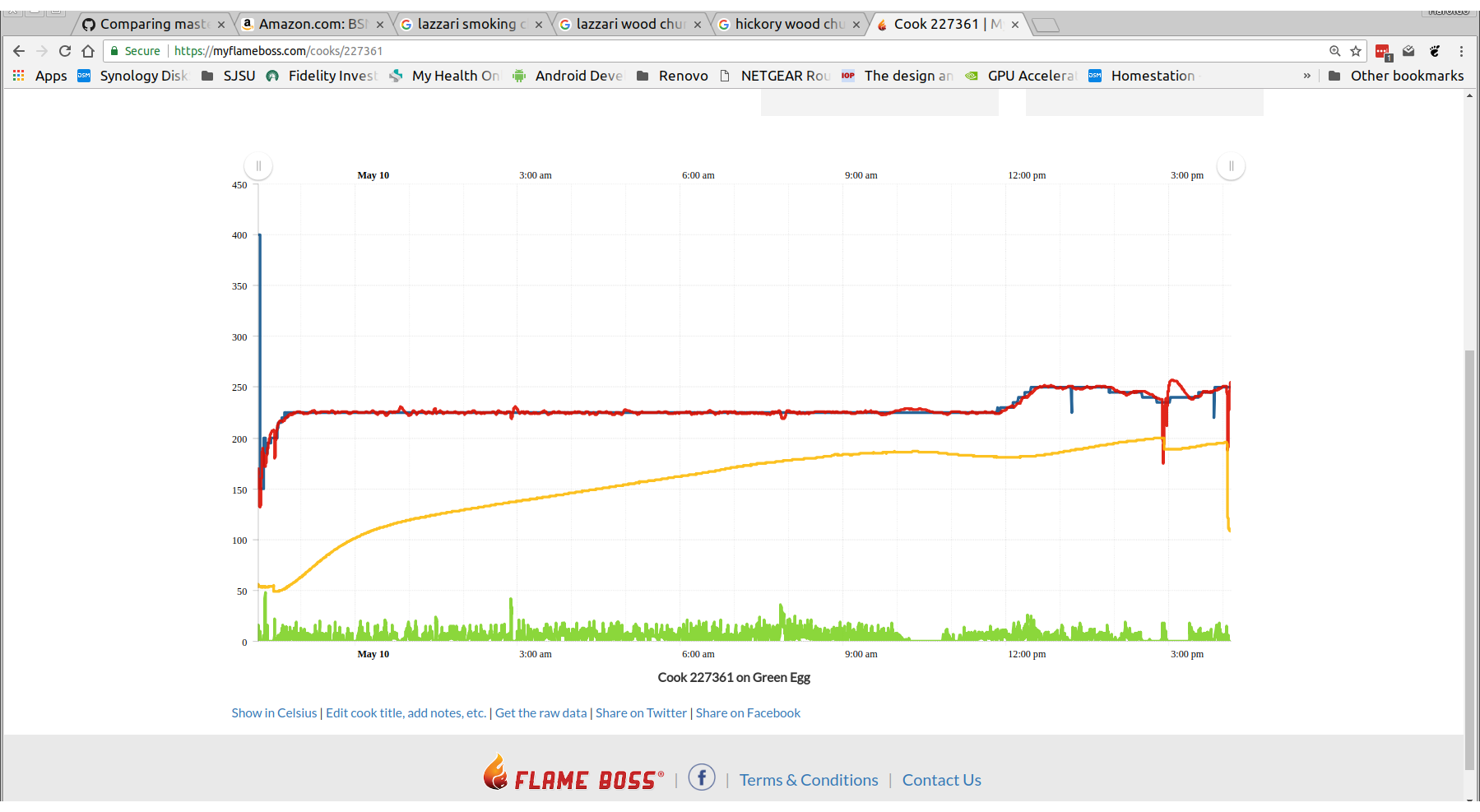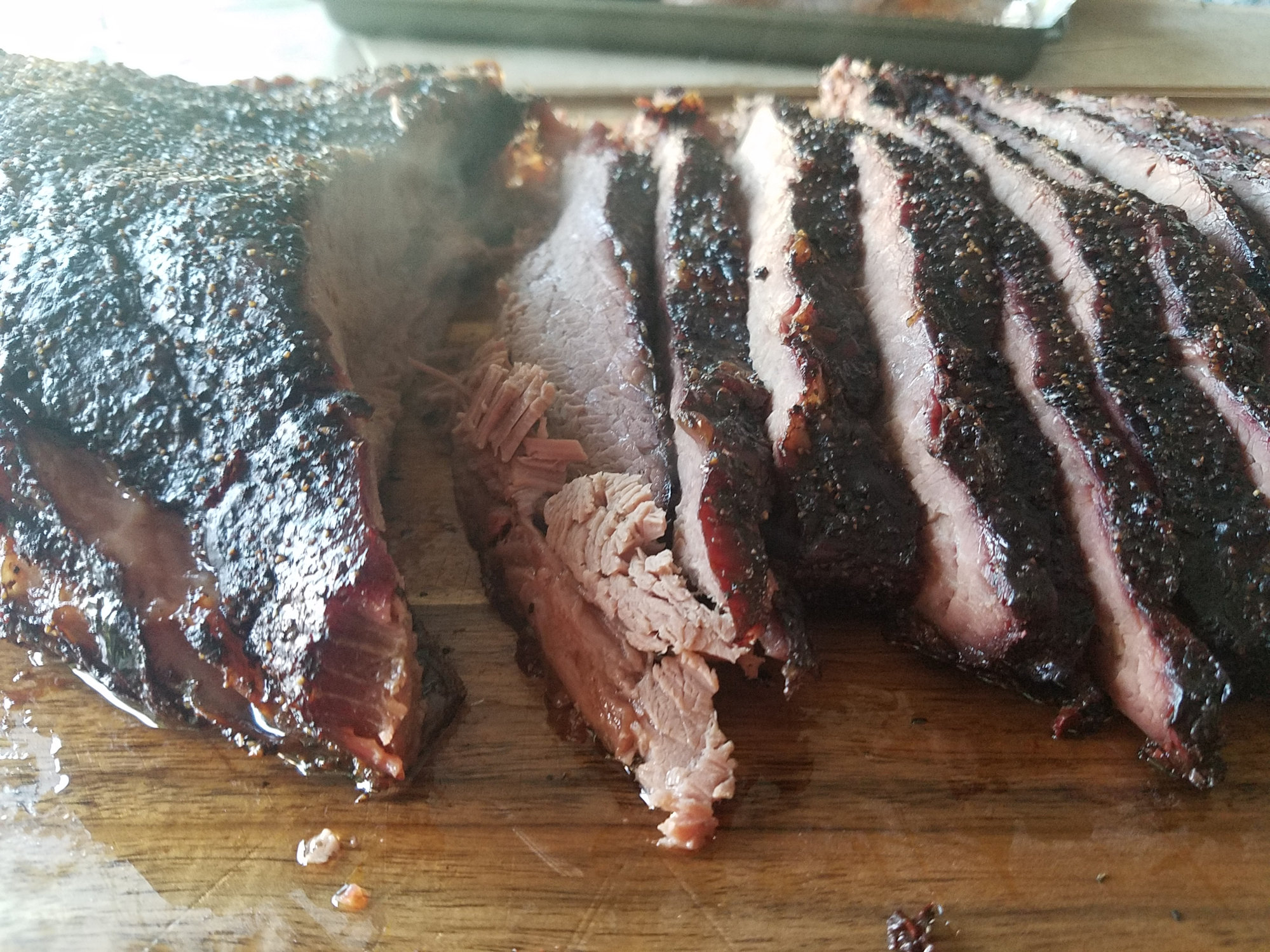Welcome to the EGGhead Forum - a great place to visit and packed with tips and EGGspert advice! You can also join the conversation and get more information and amazing kamado recipes by following Big Green Egg to Experience our World of Flavor™ at:
Want to see how the EGG is made? Click to Watch
Facebook | Twitter | Instagram | Pinterest | Youtube | Vimeo
Share your photos by tagging us and using the hashtag #BigGreenEgg.
Share your photos by tagging us and using the hashtag #BigGreenEgg.
Want to see how the EGG is made? Click to Watch
New member, many (brisket) questions
haroldopsf
Posts: 37
Hello all
I've owned an XL since April, and I'm addicted to cooking on it, more so than actually eating. Its weird. I nailed ribs, steaks, chicken (both legs quaters and whole rotisserie bird with Joetisserie). The brisket is coming along a bit slower.
Briskets number 1 and 2 were lean flats from grocery store. They came out as good as my shoe due to a combination of poor technique on my part and the bad cut.
The third brisket, however, came out pretty damn good if I may say so myself. It was a Costco prime whole packer, rubbed Franklin style and smoked with hickory chunks. It was amazing, at least the point.
If you could please shed some light on these questions:
1) See in the flame boss graph below. I have the pit probe (read line) hooked up to the dome thermometer, and not at the grate. See the pit temp (dome) was dead smack steady at 225 the whole time since the previous evening. The Brisket temp (yellow line) rose steadily, and then, right about noon, it dropped 6 degrees from 187 to 181, without any drop in pit. See I then freaked out and raised the pit temp to drag it back up. What could cause such a mysterious drop in meat without any pit temp drop? Could it be that the fire actually cooled off but the temp up in the dome did not reflect?
2) Where the heck is the stall? I see it kept on climbing past 160 and it never stalled
3) The point cooked faster than the flat. I placed the brisket East-West on the egg. Next time, would it be a good idea to place it North-South with the flat towards the rear (south) since this is the hottest spot on the egg?
4) I'm thinking of ways I can add water to the pan inside the egg without raising the fire temp by opening the lid. Tell me if this is a bad idea, but I was thinking of slowly pouring a trickle of water from the top vent down the egg as to hit the brisket and drip down the water pan.
Any help would be appreciated, about to go get my fourth brisket to practice again tomorrow

Comments
-
Give the search function a go or peruse the below thread:
RE: Memorial Day Weekend Brisket Cook: Who's with me? Rules are simple....
You may be overwhelmed with the possibilities. Grab a process and go-note the outcome and change up what you want and go again. Good luck.
Always remember, "The friggin cow drives the cook."
Edit: Welcome aboard and enjoy the journey. Above all, have fun,Louisville; Rolling smoke in the neighbourhood. # 38 for the win. Life is too short for light/lite beer! Seems I'm livin in a transitional period. -
-
I certaintly haven’t mastered brisket, and it is impressive you are already on your fourth try. I think that the normal procedure for brisket is putting it north south with the point at the back. And as far as a water pan is concerned most people here say one is not necessary on The BGE. Also you may try putting your probe in the thickest part of the flat , and probing for tenderness starting at about 190 , apparently prime cooks quicker. Again I haven’t mastered brisket , but these are things I have picked up from the site.
Dallas, TX -
I'm no brisket expert, have only cooked flats, partly because they're all I see in my stores, and partly because it's usually just me and my wife, and whole packer would be something we could never eat without freezing most of it, and it's not as good afterward, in my opinion.
But I'd say that part where it started to dip lower in meat temperature WAS a bit of a stall. If you hadn't raised the pit temp, that would have been more obvious. And think back carefully about the tenderness of the brisket. Was it plenty tender? Sometimes brisket is wonderful at 200° or below, but a few times I've had to go higher than 200° internal temp before it was truly tender. If yours tasted wonderful but was still a little chewy, it might have been still in the stall when you pulled it off the Egg.
Some people will deliberately take them out of the Egg at a certain temperature, expecting them not quite to be done, but then plan to wrap them in foil and towels and put them in a cooler to basically continue very slowly cooking in the cooler, and they finally get tender in the cooler. I'm too impatient and I don't want to have a fire burning near my house when I'm asleep, so I don't usually FTC (foil, towel, cooler) them, but let them rest for 15 or 20 minutes, and carve em up, so I want it tender when I pull it out of the Egg.
I'll hope some real brisket experts will chime in. -
Welcome aboard!
Question 1 & 2 on the stall and evaporative cooling: https://amazingribs.com/more-technique-and-science/more-cooking-science/understanding-and-beating-barbecue-stall-bane-all
Looking at your graph it looks like the rise in IT slows more noticeably around 9 - 10 AM, eventually peaking and lowering with the evaporative cooling.
#3 - I always place briskets North-South with the point towards the back. The point has substantially more fat and has a larger finish window than the flat. You'll see far more placed like this than the reverse.
#4 - a trickle of water on your brisket could wash away or soften your bark. A water pan is optional and should you use one it shouldn't take long to add a little hot water if necessary and close the lid. I'm assuming your flame boss recognized the lid opened and didn't keep blowing in an attempt to get back to temp. If your temp does spike a little it isn't a big deal.
Share some pics of your next cook!
XL, Large, Small, Mini Eggs, Shirley Fabrication 24x36 Patio, Humphrey's Weekender, Karubecue C-60, MAK 1-Star General, Hasty Bake Gourmet, Santa Maria Grill, Webers: 14" WSM, 22.5" OTG, 22.5" Kettle Premium, WGA Charcoal, Summit S-620 NG
Bay Area, CA -
Thanks everyone for the replies, tips, and thread links. I forgot to say, that brisket did actually come out soft, and delicious. The probe penetrated the point as it if was warm butter. On the flat it had to puncture through the bark (the bark was a bit dry on the flat side), but once it, there was very little probe resistance. When I pulled out the flat was at about 198 (the point must have been at 205). The dip in temp was while the probe was still on the point.
After reading Frankling's manifesto last couple of days, I realized I cut the point incorrectly, following the same orientation as the flat, while it should have been perpendicular. Oh well, it was still awesome.
The flat bark was a bit dry I thought. Anyway, people really liked it. . Tonight I'll start the forth one. They only had 1 left at costco, it was a 20 pounder. Its only my wife and I, we have no kids. I just want to cook this thing, so will have to invite people over, or eat left overs for a week : D
Here is a pic of this past brisket (I need to learn how to cut):
-
I wouldn't worry about the point much. It has so much fat in it that it wont dry out. IF your point is probing like butta than its done, if not let it ride a little bit longer.Large and Small BGECentral, IL
-
One more thing, tonight I want to do a few things differently:
- place it north south with point towards the back
- cook at 250 on the dome instead of 225. I think this high piece would take too long at 225 and dry out Frankling raves about 275 in his book
- Frankling wraps his pieces so they stop loosing moisture between the stall and final temp. That makes sense. I will try wrapping after the stall with butcher paper
- will use oak chunks instead of hickory. -
@haroldopsf Just sent you a PM that you may find of interest regarding brisket cooks.Louisville; Rolling smoke in the neighbourhood. # 38 for the win. Life is too short for light/lite beer! Seems I'm livin in a transitional period.
-
Don’t get lost in what Franklin or someone else does. Franklin uses an offset. You use an egg. If you like hickory, use hickory. I wrapped one brisket in butchers paper and then never did it again. Too much work and the results were negligible. Don’t stress over little details. Have fun, enjoy the cook and the eating that follows. Get the basics down first then start adding different techniques.Pittsburgh, PA. LBGE
-
Focus on the thickest part of the flat being probe tender. You have a large range for the point to be probe tender but a small range for the flat. Personally I don’t temp or probe the point at all and just focus on the flat.XL, Large, Small, Mini Eggs, Shirley Fabrication 24x36 Patio, Humphrey's Weekender, Karubecue C-60, MAK 1-Star General, Hasty Bake Gourmet, Santa Maria Grill, Webers: 14" WSM, 22.5" OTG, 22.5" Kettle Premium, WGA Charcoal, Summit S-620 NG
Bay Area, CA
Categories
- All Categories
- 182.7K EggHead Forum
- 15.7K Forum List
- 459 EGGtoberfest
- 1.9K Forum Feedback
- 10.3K Off Topic
- 2.2K EGG Table Forum
- 1 Rules & Disclaimer
- 9K Cookbook
- 12 Valentines Day
- 91 Holiday Recipes
- 223 Appetizers
- 516 Baking
- 2.4K Beef
- 88 Desserts
- 163 Lamb
- 2.4K Pork
- 1.5K Poultry
- 30 Salads and Dressings
- 320 Sauces, Rubs, Marinades
- 543 Seafood
- 175 Sides
- 121 Soups, Stews, Chilis
- 35 Vegetarian
- 100 Vegetables
- 312 Health
- 292 Weight Loss Forum





